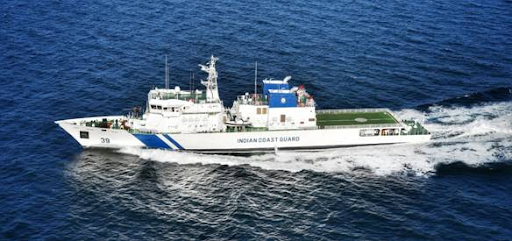Important Facts For Prelims
ICGS Vigraha
- 30 Aug 2021
- 3 min read
Why in News
The Offshore Patrol Vessel (OPV) Indian Coast Guard Ship (ICGS) Vigraha was commissioned into the Indian Coast Guard (ICG).
- It is the last vessel in the series of seven OPVs built by Larsen & Toubro (Private Company) under an Ministry of Defence contract signed in 2015.
- In May 2021, OPV Sajag was commissioned into the ICG.
Key Points
- About:

- It is about 98 metres long, 15 metres wide, has 3.6 metres draught, with 2,140 tonnes displacement and a range of 5,000 nautical miles.
- It can attain a sustained speed of up to 26 knots.
- It is fitted with advanced technology radars, navigation & communication equipment, sensors and machinery capable of operating in tropical sea conditions.
- It is also equipped with an integrated bridge system, integrated platform management system, automated power management system and high-power external fire-fighting system.
- It is armed with a 40/60 Bofors gun and fitted with two 12.7 mm Stabilised Remote Control Gun with fire control system.
- Special Capability:
- To carry one twin-engine Helicopter and four high speed boats for boarding operation, search & rescue, law enforcement and maritime patrol.
- Capable of carrying pollution response equipment to contain oil spills at sea.
- Offshore Patrol Vehicles:
- OPVs are long-range surface ships, capable of operation in maritime zones of India, including island territories with helicopter operation capabilities.
- Their roles include coastal and offshore patrolling, policing maritime zones of India, control and surveillance, anti-smuggling and anti-piracy operations with limited wartime roles.
Indian Coast Guard
- It is an Armed Force, Search and Rescue and Maritime Law Enforcement agency under the Ministry of Defence. It is headquartered in New Delhi.
- It was established in August 1978 by the Coast Guard Act, 1978 as an independent Armed force of India.
- The concept of forming ICG came into being after the 1971 war. The blueprint for a multidimensional Coast Guard was conceived by the visionary Rustamji Committee.
- It has jurisdiction over the territorial waters of India including contiguous zone and Exclusive Economic Zone (EEZ).
- It is responsible for marine environment protection in maritime zones of India and is coordinating authority for response to oil spills in Indian waters.




